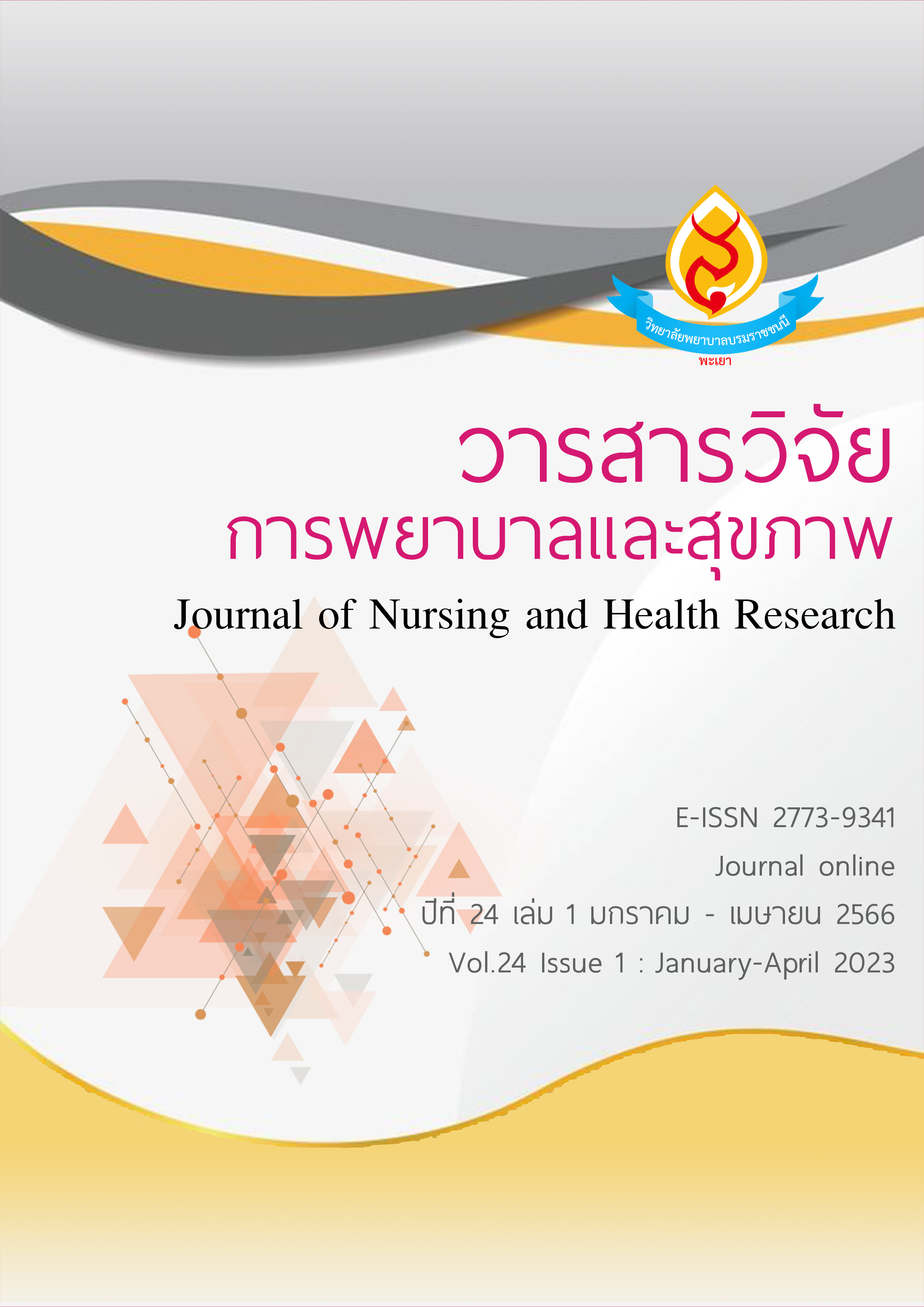ความสัมพันธ์ระหว่างการรับรู้และพฤติกรรมการป้องกันโรคติดเชื้อไวรัสโคโรนา 2019 ของผู้ป่วยเบาหวาน
คำสำคัญ:
การรับรู้, พฤติกรรมการป้องกัน, โรคติดเชื้อไวรัสโคโรนา 2019, ผู้ป่วยเบาหวานบทคัดย่อ
ผู้ป่วยโรคเบาหวาน เป็นกลุ่มที่มีความเสี่ยงสูงหากเกิดติดเชื้อไวรัสโคโรนา 2019 มีโอกาสสูงที่จะมีอาการ
ติดเชื้อรุนแรงและเสียชีวิตเมื่อเทียบกับผู้ป่วยทั่วไป เนื่องจากมีระดับภูมิต้านทานต่ำ การมีพฤติกรรมการป้องกันโรคติดเชื้อไวรัสโคโรนา 2019 จึงเป็นเรื่องสำคัญ การวิจัยเชิงพรรณนาเพื่อหาความสัมพันธ์ครั้งนี้ มีวัตถุประสงค์เพื่อศึกษา ความสัมพันธ์ระหว่างการรับรู้เกี่ยวกับการติดเชื้อไวรัสโคโรนา 2019 กับพฤติกรรมการป้องกันโรคติดเชื้อไวรัสโคโรนา 2019 ของผู้ป่วยเบาหวาน เลือกกลุ่มตัวอย่างแบบเจาะจง โดย กลุ่มตัวอย่างคือผู้ป่วยเบาหวานที่มารับการรักษาที่โรงพยาบาลส่งเสริมสุขภาพตำบลบ้านต๊ำ จังหวัดพะเยา จำนวน 91 คน เครื่องมือวิจัย ประกอบด้วย แบบสอบถามการรับรู้เกี่ยวกับการติดเชื้อไวรัสโคโรนา 2019 และแบบสอบถามเกี่ยวกับพฤติกรรมการป้องกันโรคติดเชื้อไวรัส
โคโรนา 2019 ได้รับการตรวจสอบคุณภาพจากผู้เชี่ยวชาญ 3 คน มีค่าดัชนีความสอดคล้องอยู่ระหว่าง 0.67-1.00
มีค่าสัมประสิทธิ์อัลฟ่าของครอนบาค เท่ากับ .90 และ .90 ตามลำดับ วิเคราะห์ข้อมูลด้วยสถิติพรรณนาและวิเคราะห์ความสัมพันธ์โดยใช้สถิติสหสัมพันธ์ของเพียร์สัน ผลการวิจัย พบว่า กลุ่มตัวอย่างมีการรับรู้เกี่ยวกับโรคติดเชื้อไวรัส
โคโรนา 2019 อยู่ในระดับดี เมื่อพิจารณารายด้าน พบว่า การรับรู้โอกาสเสี่ยงและการรับรู้ความรุนแรง อยู่ในระดับดี แต่การรับรู้ประโยชน์ของการรักษาและปฏิบัติพฤติกรรมการป้องกันโรคติดเชื้อไวรัสโคโรนา 2019 และการรับรู้อุปสรรคของการปฏิบัติ อยู่ในระดับปานกลาง ส่วนพฤติกรรมการป้องกันโรคติดเชื้อไวรัสโคโรนา 2019 อยู่ในระดับดี และการรับรู้เกี่ยวกับการติดเชื้อไวรัสโคโรนา 2019 มีความสัมพันธ์ในระดับปานกลาง (r=0.634) กับพฤติกรรมการป้องกันโรคติดเชื้อไวรัสโคโรนา 2019 อย่างมีนัยสำคัญทางสถิติ (p<.05) ดังนั้นควรส่งเสริมให้ผู้ป่วยเบาหวานมีการรับรู้เกี่ยวกับโรคติดเชื้อไวรัสโคโรนา 2019 เพื่อการมีพฤติกรรมการป้องกันโรคติดเชื้อไวรัสโคโรนา 2019 ที่ดี
เอกสารอ้างอิง
กลุ่มพัฒนาวิชาการโรคติดต่อ. (2564). สถานการณ์โรคติดเชื้อไวรัสโคโรนา 2019 (COVID-19) มาตรการ สาธารณสุข และปัญหาอุปสรรคการป้องกันควบคุมโรคในผู้เดินทาง. จาก https://ddc.moph.go.th/uploads/files/2017420210820025238.pdf
กรมควบคุมโรค. (2565). สถานการณ์ผู้ป่วยโควิดภายในประเทศรายสัปดาห์. จาก https:// ddc.moph.go.th/covid19-dashboard/
กองโรคไม่ติดต่อ กรมควบคุมโรคและสถาบันเวชศาสตร์สมเด็จพระสังฆราชญาณสังวรเพื่อผู้สูงอายุ กรมการแพทย์. (2564). รายงานผลการทบทวน ผลกระทบของ COVID-19 ต่อระบบบริการโรคไม่ติดต่อเรื้อรัง. จาก https://ddc.moph.go.th/uploads/publish/1187720211012064924.pdf
ธานี กล่อมใจ จรรยา แก้วใจบุญ และ ทักษิกา ชัชวรัตน์. (2563). ความรู้และพฤติกรรมของประชาชนเรื่องการป้องกันตนเองจากการติดเชื้อไวรัสโคโรนา สายพันธุ์ใหม่ 2019.วารสารการพยาบาลการสาธารณสุขและการศึกษา, 21(2), 29-39.
รายงานประจำปี รพ.สต.บ้านต๊ำ. (2563). สถิติข้อมูลโรคไม่ติดต่อเรื้อรัง ปี 2563. โรงพยาบาลส่งเสริมสุขภาพตำบลบ้านต๊ำ.
วิญญ์ทัญญู บุญทัน, พัชราภรณ์ ไหวคิด, วิภาพร สร้อยแสง, ชุติมา สร้อยนาค, ปริศนา อัครธนพล และ จริยาวัตร คมพยัคฆ์. (2563). ปัจจัยที่มีอิทธิพลต่อพฤติกรรมการสร้างเสริมสุขภาพในการป้องกันการติดเชื้อไวรัสโคโรนา 2019 (โควิด-19) ของผู้สูงอายุ. วารสารพยาบาลตำรวจ, 12(2), 323-337.
วรรณรา ชื่นวัฒนา และ ณิชานาฏ สอนภักดี. (2557). พฤติกรรมการดูแลสุขภาพตนเองของผู้ป่วยโรคเบาหวาน ตำบลบางแม่นาง อำเภอบางใหญ่จังหวัดนนทบุรี. วารสารวิชาการ มหาวิทยาลัยปทุมธานี, 6(3), 163-170.
ศูนย์บริหารสถานการณ์การแพร่ระบาดของโรคติดเชื้อไวรัสโคโรนา 2019 จังหวัดพะเยา (ศบค.พย). (2565). รายงานผู้ติดเชื้อโควิด-19 จังหวัดพะเยา. สืบค้นเมื่อ 2 กุมภาพันธ์ 2564 จาก www.phayao.go.th/covid/#home
อานนท์ สีดาเพ็ง และ นิคม มูลเมือง. (2556). พฤติกรรมส่งเสริมสุขภาพของนักศึกษามหาวิทยาลัย. วารสารศิลปศาสตร์ มหาวิทยาลัยแม่โจ้, 1(1), 59-85.
อัจนา เจศรีชัย. (2563). ปัจจัยทำนายพฤติกรรมการดูแลสุขภาพตนเองของผู้สูงอายุที่ป่วยด้วยโรคเบาหวาน จังหวัดพิจิตร. วารสารวิจัยและวิชาการสาธารณสุขจังหวัดพิจิตร. 1(1), 24–34.
ฮูดา แวหะยี. (2563). การรับรู้ความรุนแรงและพฤติกรรมการป้องกันโรคติดเชื้อไวรัสโคโรน่า 2019 (โควิด-19) ของวัยรุ่นในเขตตำบลสะเตงนอก อำเภอเมือง จังหวัดยะลา. วารสารวิชาการสาธารณสุขชุมชน, 6(4), 158-168.
Becker, M. H. (1974) The health belief model and personal health behavior. Health Education Monographs, 2, 324-508.
Bloom, B. S., Hastings, J. T., & Madaus, G. F. (1971). Handbook on Formative and Summative Evaluation of Student Learning. New York: Mc Graw-Hill Book Company.
Nikoloski, Z., Alqunaibet, A. M., Alfawaz, R. A., Almudarra, S. S., Herbst, C. H., El-Saharty, S., … Algwizani, A. (2021). Covid-19 and non-communicable diseases: evidence from a systematic literature review. BMC Public Health, 21(1), 1068. doi: 10.1186/s12889-021-11116-w
Pender, N. J., Murdaugh, C. L., & Parson, M. A. (2006). Health promotion in nursing practice (5thed.). Upper Saddle River, NJ: Prentice-Hall.
Roncon, L., Zuin, M., Rigatelli, G., & Zuliani, G. (2020). Diabetic patients with COVID-19 infection are at higher risk of ICU admission and poor short-term outcome. Journal of Clinical Virology: the Official Publication of the Pan American Society for Clinical Virology, 127, 104354. doi: 10.1016/j.jcv.2020.104354
Williamson, E. J., Walker, A. J., Bhaskaran, K., Bacon, S., Bates, C., Morton, C. E., … Goldacre, B. (2020). Factors associated with COVID-19-related death using OpenSAFELY. Nature, 584(7821), 430–436. doi:10.1038/s41586-020-2521-4
World Health Organization. (2023). WHO Coronavirus (COVID-19) Dashboard. Retrieved 2 February 2021, from https://covid19.who.int/
ดาวน์โหลด
เผยแพร่แล้ว
รูปแบบการอ้างอิง
ฉบับ
ประเภทบทความ
สัญญาอนุญาต
ลิขสิทธิ์ (c) 2023 วารสารวิจัยการพยาบาลและสุขภาพ

อนุญาตภายใต้เงื่อนไข Creative Commons Attribution-NonCommercial-NoDerivatives 4.0 International License.



